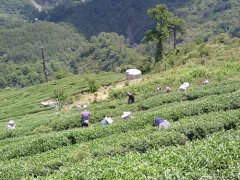Authentic yellow branch fragrant phoenix single fir tea where to buy? The taste and characteristics of real Song species yellow branch single fir
Huangzhixiang Dancong Oolong this is one of the most traditional oolong tea, produced from a very ancient variety. In terms of variety and mode of production, it is the oldest of its kind. The real traditional Huangzhixiang lies between the sweeter modern classical style Phoenix Oolong tea and the flower basket style. It has a very special flavor that works well through normal and kung fu brewing methods. Let's take a look at the name of Huang Zhixiang again: Huang Zhixiang is the oldest tea name in Phoenix Oolong Tea area. Some people mistakenly think that it is a "yellow stem", which refers to a yellow petiole. Huangzhi (yellow tangerine, which later evolved to be called Huangzhi, and thus became so popular) is actually a local mispronunciation of mandarin characters where the term kumquat. Kumquat is a small citrus fruit that looks like a tiny, smooth oval orange. When it is fully ripe, people will eat it with the skin. It tastes sweet, but the astringency is unexpectedly low, reminiscent of the taste behind oranges. Pleasant aftertaste, thirst quench refreshing. This kind of tea is named after this fruit for a reason-it has a strong aroma and taste, and even a fruity floral and honey flavor. What I describe here is only the real quality. The market is full of different products with the same name. Let's go back to the name. "single fir" means that the leaves of each tea tree are processed separately to keep the taste of the tree clear and unique. This is contrary to the practice of mass production of tea by evenly trimmed tea hedges in tea gardens. The tea trees here grow very big and have plenty of space. One of my clients calls these "free-range tea trees". The "Song" variety in the Song Dynasty refers to the tea variety propagated from a live (and produced) tea tree in the Southern Song Dynasty in the 13th century. Another variety can be traced back to the same era variety Zhilan Xiang Dancong, a typical expression of flower-scented Phoenix Dancong tea. All these are vivid proof of the history of oolong tea production in the region. There are a large number of very old shrubs and trees in the area, each of which is called a few years old or a hundred years old by its owners, and each produces a different variety of Phoenix clumps. The appearance of plants and the taste of harvest are different. Farmers here actively reproduce these different varieties asexually near the mother tree.
According to the official statistics of the local government, there are 123 special varieties of Shan fir. Huang Bozi, the pioneer of Phoenix Oolong study, divided Oolong into 18 different groups. We'll write about this later. The "offspring" of many centuries-old plants themselves have a history of more than 100 years. At the end of April or early May, people across the country drive along winding paths, waiting for a bumper harvest of crops so that they can buy them immediately. Some people are end users who are crazy about getting the real thing and are willing to pay hundreds of thousands of yuan (RMB) for the output of a few kilograms of a tree. Most people are wholesalers and teahouse owners, bidding for tea from these famous bushes. Most people do not realize that deceptive farmers collect green leaves from all neighboring villages instead of real leaf processing. The real Huang Zhixiang the real Song Huang Zhixiang single clump is rare. Sometimes I really feel guilty and immerse myself in this special delicacy. I compared directly from the real old shrub and from its reproduction. For me, wine carefully processed by well-cared and mature offspring tastes better. To be sure, its reputation is not as respectable as the original taste of thousands of yuan a kilogram, but what matters to me is the quality of the taste. In addition to the aroma of kumquat, the main taste and aroma of this fine wine is a typical high-altitude single clump of flowers, complex and attractive aroma, smooth body depth conveys a silky touch. The bitterness and sweetness of many fruits interact fascinatingly with the forest-like depth of slowly baked oolong tea. Then there is quenching, lasting sweetness after the taste, making every mouthful of oolong tea love. There are about 30 to 40 wholesale tea markets in China, and most stores can sell you anything that weighs 1/4 kilograms at wholesale prices. I have entered many samples of their stuff and are amazingly disappointed with the quality almost always experienced. The price is definitely not the mark of the authentic product. The more a stranger I am, the more this is the case. I'm not sure how many of these stores really believe what they sell, or that they are the victims of deception.
Important Notice :
前街咖啡 FrontStreet Coffee has moved to new addredd:
FrontStreet Coffee Address: 315,Donghua East Road,GuangZhou
Tel:020 38364473
- Prev

What is the flavor type of Shiguping oolong tea? The difference between Shi Guping and Wenshan Bao planting Oolong
Shiguping, also known as Shiguping and Shiguping, is the name of a village in Bu County of Fenghuang area. It is well known that oolong tea is produced only in a small number of tea lovers rather than daffodils, but the native oolong variety is so ancient and unique that it may be the ancestor of oolong tea in southern Fujian and Taiwan. No.
- Next

Honey snow ice city, the first experience shop in the country, stewed noodles, milk tea, pancakes, ice cream is not uncommon, there are fried kebabs!
You love me, I love you, Snow Ice City Sweet Honey, everyone must have drunk Honey Snow Ice City, right? Honey Snow Ice City is currently one of the largest milk tea chain brands in China. Its official website shows that there are 10,000 + stores in China, covering a wide range of stores. On the way home, there is one on the street and one at the end of the street.
Related
- What effect does Italian American coffee with filter paper have? Will coffee taste better if it is put on filter paper at the bottom of the powder bowl?
- What is the color difference in coffee beans? What are the characteristics of honey processed coffee beans? Why are the anaerobically treated coffee beans uneven in color?
- How does novice Xiaobai quickly get started and make coffee? Newbies learn to make coffee by hand and share the specific steps and process process!
- Costa tea has a shelf life of 100 years?! Expert: Unable to verify
- It's a huge uproar! American milk addition was rejected by Manner employees?!
- Mocha pot coffee bean recommendations| How fine and how much powder should be used for grinding? What parameter ratios do I need to use to make milk with Mocha pot coffee?
- What are the characteristics of the world's top ten coffee beans treated with Costa Rica honey? How to make black honey kadura from Tarazhu Pilon Processing Plant taste good?
- How to make deep-roasted coffee? What grinding water temperature does authentic Jamaica Blue Mountain No. 1 coffee use to brew it well?
- Selected high-grade rose summer coffee flavor tasting guide Why Panama rose summer has the aroma of flowers and fruits
- What equipment does a novice Xiaobai need to buy to learn to make coffee? Filter cup electronic scale bean grinder manual flushing pot purchase guide

